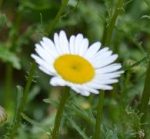 Oxeye daisy is a rhizomatous perennial and belongs to the aster family, Asteraceae, that also includes sunflowers, yarrow, and lettuce. It is native to Europe and Asia but was introduced to North America and is now found throughout the US where it grows in lawns, vacant lots, pastures, meadows, rangelands, edges of waterways and along roadsides and railroad tracks. Plants prefer full sun to partial shade and moist soil, and often form dense colonies.
Oxeye daisy is a rhizomatous perennial and belongs to the aster family, Asteraceae, that also includes sunflowers, yarrow, and lettuce. It is native to Europe and Asia but was introduced to North America and is now found throughout the US where it grows in lawns, vacant lots, pastures, meadows, rangelands, edges of waterways and along roadsides and railroad tracks. Plants prefer full sun to partial shade and moist soil, and often form dense colonies.
Description: Growing one to three feet tall from a rhizomatous rootstock, oxeye daisy has a smooth mostly unbranched stem that carries dark green lobed leaves. The lower leaves have slender petioles and are spoon-shaped and up to five inches long while the upper leaves are smaller and clasp the stem. The flower heads are up to two inches across and are borne singly on the tips of the stems from mid summer into fall. Each flower head consists of fifteen to thirty five white ray flowers surrounding a center of yellow disc flowers and are followed by seed heads of one seeded fruits called achenes. A single plant can produce up to 26,000 seeds, most of which can remain viable in the soil for up to six years. Reproduction is by seed and rhizomes.
Control: Oxeye daisy is difficult to control because of its abundant long lasting seed production, and the fact that even small fragments of rhizomes left in the soil can give rise to new plants. In addition the plant is resistant to many herbicides such as MCPA, 2,4-D, and dicamba. Hoe or pull seedlings as soon as they appear; dig out or cut back large plants every couple of weeks until they stop sprouting digging at least six inches deep so as to remove all the root. Since the seeds live in the soil for many years, progress in eradication may be slow and great persistence needed to be successful.